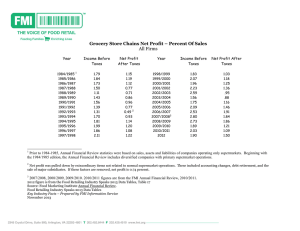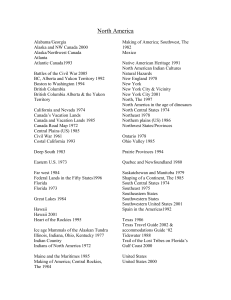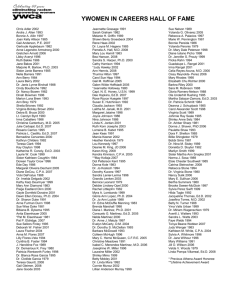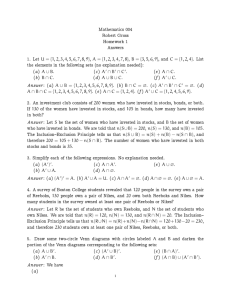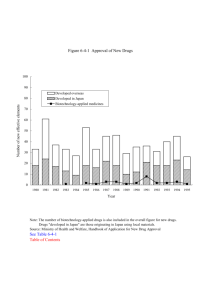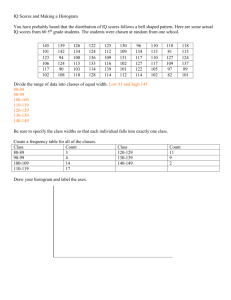Document 11859518
advertisement
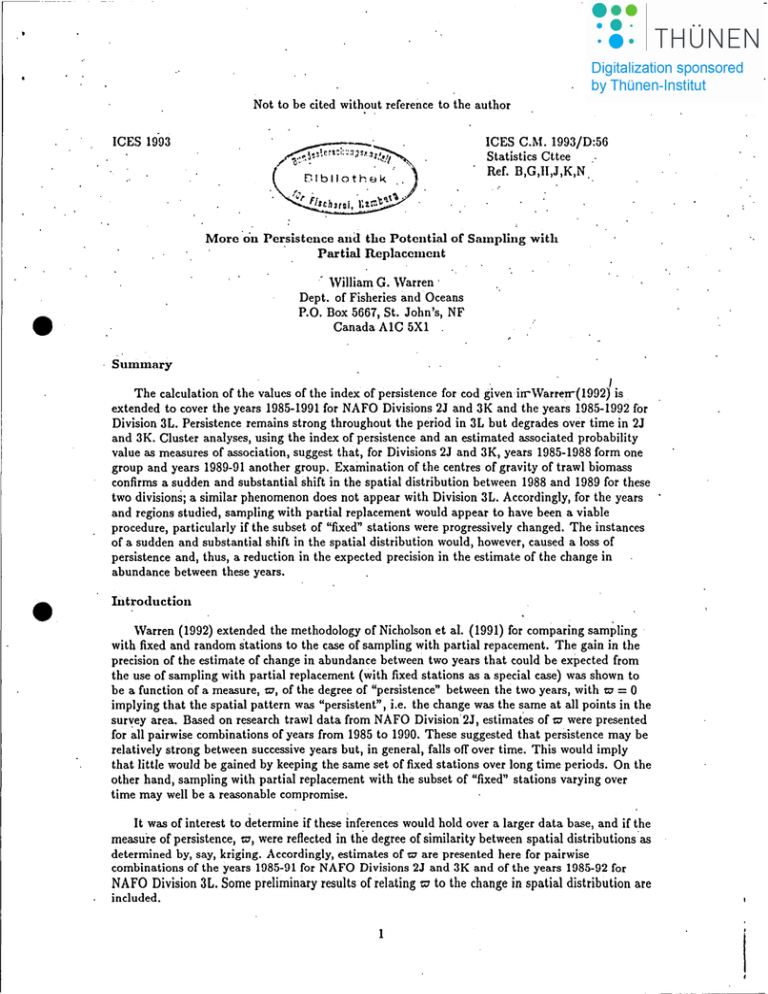
Not to be cited without reference to the author
ICES 1993
ICES C..M. 1993/D:56
Statistics Cttee
Ref. B,G,II,J,K,N,
~>~,.~\cr':i:::1J!1.';1'
I
...
·o!.l,
/"ö.:'\~,
> •• > " " " ,
DlblJothek.
Morc 'au Pcrsistcuce aud tbc Potcutial of Sampling witll
,
Partial Rcplaccmcut
•
. William G. Warren '
Dept. of Fisheries and aceans
P.O. Box 5667, St. John's, NF
Canada AIC 5Xl .
Summary
givenirrWar~rr(19921
The calculation of the values of the index of persistence for cod
is
extended to cover the years 1985-1991 for NAFO Divisions 2J and 3K and the years 1985-1992 for
Division 3L. Persistence remains strong throughout the period in 3L but degrades over time in 2J
and 3K. Cluster analyses, using the index of persistence and an estimated associated probability
value as measures of association, suggest that, for Divisions 2J and 3K, years 1985-1988 form one
group and years 1989-91 another group. Exainination of the centres of gravity of trawl biomass
confirms a sudden and substantial shirt in the spatial distribution between 1988 and 1989 for these
two divisions; a similar phenomenon does not appear with Division 3L. Accordingly, for the years
and regions studied, sampling with partial replacement would appear to have been a viable
procedure, particularly if the subset of "fixed" stations were progressively changed. The instances
of a sudden and substantial shift in the spatial distribution would, however, caused a loss of
persistence and, thus, a reduction in the expected precision in the estimate of the change in
abundance between these years.
•
Iutroduetiou
Warren (1992) extended the methodology of Nicholson et al. (1991) for comparing sampling
with fixed and random stations to the case oe sampling with partial repacement. The gain in the
precision of the estimate oe change in abundance between two years that could be expected from
the use of sampling with partial replacement (with fixed stations as a special case) was shown to
be a function of a measure, t<7, of the degree of "persistence" between the two years, with t<7 = 0
implying that the spatial pattern was "persistent", i.e. the change was the same at all points in the
survey area. Based on research trawl data from NAFO Division'2J, estimates of t<7 were presented
for ~ll pairwise combinations of years from 1985 to 1990. These suggested that persistence may be
relatively strong between successive years but, in general, falls off over time. This would imply
that little would be gained by keeping the same set of fixed stations over long time periods. On the
other hand, sampling with partial replacement with the subset of "fixed" stations varying over
time may weIl be a reasonable compromise.
It was of interest to determine if these inferences would hold over a larger data base, and ie the
measure persistence, t<:7, were reflected in the degree similarity between spatial distributions'as
determined by, say, kriging. Accordingly, estimates of t<7 are presented here for pairwise
combinations of the years 1985-91 for NAFO Divisions 2J and 3K and of the years 1985-92 for
NAFO Division 3L. Some preliminary results relating t<7 to the change in spatial distribution are
included.
oe
oe
oe
1
2
S; =
ny
I .
[L L(Xiy -
Xy )2]/(n1
..;1
.y=1i=1 .
+ n2 ~ 2)
.
where n1 arid n2 denote. the numbers of stations in the two years, and
ny
.
i=1
.
.xy =Lx~y/ny.
Further,'Iet d i = Xu - Xi2' Then
Var(d i ) is estimated I as
.
1
where the summation isO over the n "fixed" stations,
and d = E?=i ddn.
.
•
Lt those stations common to the two years,
The persistence measure is then estimated as
Implementation
,
The research trawl surveys in NAFO Divisions 2J; 2K and 3L are stratified random surveys
with the number of succesful stations ranging from 107 (3K, 1986) to 232 (3L, 1985). In Warren
(1991) stations in any two years within 2.5 nm of each other were regarded as being at the same
Iocation. The 2.5 nm was somewhat arbitrarYi it was chosen as the smalhist distanee from which a
minimally reasonable number of "fixed" stations could be generated from these data. This
procedure was followed for the present study but, to obtain some idea of how critical was the
choice of distanee, estimates with the distance extend~'d to 4.0 nm were also obtained.
. Warren (1991) presented values of Qm01:' This is not the maximum value that Q could take,
but the value obtained by, in effect, treating all stations, no matter how far apart, as being at the
same Iocation. Sinee this varied between pairs of years', it was feIt to provide a yardstick by whieh'
the calculated values of Q could be compared. While sometimes useful, Q was subsequently found
to be potentially misleading and, in the presentstudy, is replaeed by the following. For any pair of
years the number, n, of fixed stations was determined. 1Random sampIes of size n were drawn from
the data for eaeh of these years. These were matehed in the sEmse that the first sampIe drawn from
year 1 was matehed with the first drawn from year 2, although, in reality, these are independent.
These pairs were used to ealculate a s~ and, henee, a .ti:7. The proeedure was repeated 1000 times
for eaeh pair of years, and the' number of times the value so calculated fell below the actual Q
reeorded. The number beil~g less than 50 (out of 1000) 'is then equivalant to t:V being "significantly
small" at the 5% level.
.
i
i
It should be noted that the x öy used were the logarithms of the station biomass of eod (plus
1.0 to allow for zero catches). Thus t:V = 0 implies a constant percentage, rather than absolute,
change at each loeation.
.,
2
•
Results
The values of ware given in Tables 1, 2 and 3 for Divisions 2J, 3K and 3L, respectively. The
. values above the diagonal are for same-Iocation distances of 2.5 nm those below the diagonal for
4.0 nm distances.
•
Year 1985
1985
1986 0.12
1987 0.21
1988 0.45·
1989 0.65
1990 0.82
1991· 1.00
[Note: the above-diagonal values are the same as in Warr~~ (1992) with the· exception of the
. 1987-1990 combination; the 0.58 given therein is the result of a transcription error].
Year
1985
1986
1987
1988
1989
1990
1991
•
Table 1.
Values of w for Division 2J
Year
1986 1987 . 1988 1989 1990 1991
0.19 0.21 0.32 0.62 0.38 ·0.51
0.11 0.22 0.17. ·0.75 1.31
0.39 . 0.91 0.83 1.10·
0.12
0.23 0.27
0.68 0.55 1.41
0.39 0.76 0.36
0.25 0.39
0.28
0.79 0.80 0.56 0.24
2.65 . 1.36 ·0.85 0.53· 0.25
Year
1985
1986
1987
1988
1989
1990
1991
1992
1985
0.33
0.26
0.25
1.53
0.51
0.53
1985
0.24
0.27
0.19
0.16
0.34
0.59
0.28
Table 2.
Values of w for Division 3K
Year
1986 1987 1988 1989 1990
0.32 0.25 0.28 0.90 0.26
0.25 0.54 0.12 0.84
0.41
0.28 0.15 0.22
0.35 0.54
0.33 0.37
0.26
0.83 0.21 0.32
2.13 0.27 0.52 0.17
1.10 0.33 0.28 0.21 0.25
Table 3.
Values of w for Division 3L
Year
1986 1987 1988 1989 1990
0.20 0.14 0.23 0.26 0.37
0.67 0.32 0.33 0.38
0.68
0.27 0.21 0.18
0.44 0.21
0.12 0.32
0.27 0.24 0.15
0.07
0.61 0.17 0.28 .0.12
0.18 0.49 0.25 0.37 0.49
0.18 0.49 0.25 0.42 0.55
1991
0.47
1.42
0.42
0.52
0.15
0.18
1991
0.30
0.25
0.46
0.17
0.36
0.43
1992
0.27
0.12
0.35
0.18
0.82
0.26
0.26
0.32
The probabilities of obtaining values of w less than those observed, as estimated by the above
repeated-sampling approach, are given in 'Tables 4, 5 and 6 for Divisions 2J, 3K and 3L,
respectively. As with Tables 1-3, the above- and below-diagonal values refer to the 2.5 nm and 4.0
nm distances, respectively.
3
Table 4.:
Estimated probabilities (%) of tv for Division 2J
.'
. Year
.
Year 1985 1986 1987 1988 1989 1990 1991
1985.
0.6
1986
o·
1987
0
0
2.7
0
1988
0.3
1989 13.7
1990 33.8 22.8
1991 50.3 96.1
0.7
0
0
23.0
32.9
76.8
6.0
0.1
5.3
23.3
8.2
0 32.5
48.2 42.4
'22.6· 20.0·
., 0.2
0
8.2
0
. 37.8
0.6
0
I
16.1
64.0
59.0
.73.1
1.7
1:1
.
Table 5..
Estimated probabilities (%) of tv for Division 3K
Year
Year 1985 1986 1987 1988 1989 1990 1991
. 1985
1986
1987
1988
1989
1990
1991
5.9
0.9
0
0.2
87.2
4.1
4.8
2.7
3.4
39.3
84.5
62.2
0.4
2.7
',
50.5
3.6
0.5
9.1
0.7
11.7
0.1
0
0
3.2
32.2
3.2
10.0
0
0
0.5
1.9 11.5
54.8 73.0
0.6
6.7
16.9, 27.5
3.0
0.2
0.1
0.1
•
Table 6. i
Estimated ptobabilities (%) ~f tv for Division 3L
Year
Year
1985
1985
1986
1987
1988
1989
1990
1991
1992
0
0
0
0
0
5.0
0
1986
0.3
21.8
3.3
0.1
13.8
0
0
1987
0.7
29.5
0.1
0
0
2.8
3.2
1988 :1989
0
1.3
6.5
3.6
2.2 . 0.5
0
0
0
0
0.2
0
0.3
0
1990
3.9
8.6
0.2
5.1
0
1.4
3.8
1991
0.3
3.0
9.0
0.5
3.0
12.7
1992
0.3·
0
3.0
0.5
44.8
0.3
0.4
0
It will be observed that there are more than a few' instances where the observed value of tv was
less than all of the 1000 values generated for the null distribution, and that these instances are
more common when the 4.0 nm distance is used. There are likewise numerous instances where the
observed value of tv would be judged as significant at the 5% level, with the frequency of such
instanees inereasing from Division 2J through 3K to 3L.
It seems clear for Division 2J that, as observed in,Warren (1992), the persistenee between
adjaeent years is relatively strong but gradually degrades over time; this appears to be very much
the ease when the results for the 4.0 mn distanee are eonsidered. On the other hand, for Division
3L, persistence appears relatively strong throughout the whole period 1985-92. The picture for
Division 3K is less clear.
Both tv and its associated estimated probability can be regarded as measures of the degree of
association between pairs of years. Aeeordingly, they may be used to eonstruct clusters of similar
years. Various clustering algorithms are available. 'Ve here use a very simple method deseribed by
Scott (1972) and attributed by hirn to Jolliffe (1970). ;The association between two groups is
defined as the arithmetic mean of the measures of assoeiation between the members of one group
and the members of the other. At eaeh state of the clustering proeess, the two groups (whieh may
4
•
contain only one member, here a year) having the largest measure of assodation (here the smallest
numerical value, since zero implies fully persistent) are combined. If one wishes, the procedure may
be terminanted when a predetermined number of groups is attained, or the measure of association
reaches s?me prescribed value. .
. .
Dendrograms generated by the above method are presented in Figs. 1-6. Figs 1,3,5 use wand
. Figs. 2,4,6 use the associated probability as measure of assodation. Each figure has ·two.
componentsj that labelIed (80) correspondsto the 2.5 nm distance, that labelIed (b) to the 4.0 nm
·distance.
..
2J
For Division
these dendrograms suggest that two distinCt clusters can be formed from the
years, one containing the years 1985 through 1988, and the other 1989 through 1991. The picture
is the same for each combination of distance and measure of assodation with the exception that,
for the probabilty measure and 4.0 nm; 1989 is grouped with 1985-88 rather ·than 1990-9i.
•
•
For Divison 3L no clear-cut grouping emerges.
For Division 3K the pattern is similar to that for 2J in that, for the probability measure,
1985-1987 form one group and 1989-91 another, with 1988 grouped with 1989-91 when the 4.0 nm
distance is used ind with 1985-87 when the 2.5 nm distance is used. When w is used, with 2.5 nm,
1986-87 and 1989 appear to form one group and 1985, 1988 and 1990-91 another, although 1985
and 1988 could, perhaps, be regarded as a group separate from 1990-91. With 4.0 nm, 1985 and
1988, perhaps along with 1986, form one group and 1987 and 1989-1991 another. With both
distances, 1990 and 1991 occur in the same group. In this sense, Division 3K appears to be
somewhere between Divisions 2J and 3L, although perhaps more akin to 2J.
.
Table 7.
Centres of Gravity of Stations and
Trawl Biomass
lat.
long.
Division Year
1985 53.98
54.93
2J
54.79
1986 54.23
1987 54.26
54.58
1988 54.50
54.76
53.47
1989 53.49
53.42
1990 53.88
53.46
1991 52.89
Trawl Biomass
Stations
lat. long.
53.78 54.34
53.77 54.19
53.81 54.31
53.97 5438
53.78 54.16
53.84 54.13
53.89 54.15
3K
1985
1986
1987
1988.
1989
1990
1991
51.08
51.33
51.29
50.91
50.94
49.81
50.71
52.08 50.92
51.86 50.93
51.82 50.88
51.93 50.86
50.89 . 51.00
50.39 .50.69
50.66 50.97
3L
1985
1986
1987
1988
1989
1990
1991
1992
47.37
47.82
47.49
48.06
47.66
47.01
48.48
48.77
50.35
50.29
49.82
50.54
50.30
49.52
50.13
50.23
5
47.41
47.28
47.23
47.32
47.34·
47.25
47.40
47.45
52.39
52.87 •
52.51
52.73
52.57
52.05
51.97
50.25
50.45
50.24
50.36
50.42
50.04
49.91
49.83
,
-
<
;
I
-I
'
As yet, the measures of persistence have not been related to chariges in the spatial distribution
as estimated by kriging, in part because of possible instability of the variograms caused by'
movement of the fish during the period of a survey. nowever, the centre of gravity of the trawled
biomass for each combination of year and division can be calculated from the study data. The
latiiu'de and longittide of the centres of gravity are giv~n in Table 7; along with those for the centre
of gravity of the trawl stations.- The laHer are presented to determine whether any ~hift in the'
centre of gravity of the biomaSs waS due to a change in the centre of gravity of ~he,staÜons caused'
by ~ c~an"ge in the distribut!on of samplin~ ef!o~t. "
!. "".',.
....'
The locationsaof the biomass centres of gravity are plotted in Fig. 7. While the centres of
gravity of the stations remain fairly compact, especially in Division 2J, the centres of gravity of the'
trawl biomass in.Divisions 2J and 3K take a sudden arid pronounced shift to the east in 1989. In 2J
this also coincides with a shirt to the south. In 3K the're is a shirt to the south in 1990 followed by
areturn to the north in 1991. The picture in Divisin 3L is quite different. There is somewhat of a
shirt to the southest in 1990 followed by areturn and additional move northwards in 1991-92. The
behaviour is consistent with the pattern observed in the measures or persistence, particularly in
and 1989-91 in Divisions
the identification of the two groups of years, namely 1985-88
j
, 2J and
, 3K..
- I
Discussioll
~recision
•
~stimation
Warren (1992) shows, quantitativ'ely, the gains in
in the
of the change in
abundahce that would be obtained under sampling with partial replacement (or, as a special case,
fixed stations) as function of t:7. In Division 3L, sampling with partial replacement or, even, fixed
stations, would appear to have been a viable option for the period 1985-92. In Divisions 2J and 3K
sampling with partial replacement would appear to have been a viahle option but with the subset
of "fixed" stations varying over time, Le. the stations common to 1985 and 1986, say, would not be
the same as the, stations common to 1986 and 1987, et"c. The advantages of such a strategy would
have been lost, however, for the change that occurred between 1988 and 1989.
J
Thus, over the period and regions studied, persistJnce between adjacent years is commonly
strong, justifying the use of, at least, sampling with partial replacement, albeit preferably with the
"fixed" stations progressively changed. It appears, however, that sudden and substantial changes
in spatial distribution can, and do, occur causing a los's in persistence and, thus, a redtiction in the
expected precision of the estimated change in abundance. The reasons for these such changes in
spatial distribution are outside the scope of the present paper.
i
i
I
Referellces
I
,
Jolliffe, I.T. 1970. Redundant variables in multivariate analysis. Unpublished D. Phil. Thesis,
j
University of Sussex.
1
Nicholson, M.D., Stokes, T.K. and Thompson, A.B. 1991. The interaction between fish
distribution, surveydesign and analysis. ICES C.l\1. 1991/D:l1.
I
Scott, J.F. 1972. Redundent variables i~ multivariate ~nalysis. Procedings of the Third Conference
of the Advisory Group of rorest Statisticians, International Union of rorest Research'
Publ. 72-3, 153-160.
Organisations. Institut National de la Recherche Agro~omique,
,
Warren. W.G. 1992. The potential of sampiing with
ICES C.l\I. 1992/D:21.
~artial replacement for fisheries surveys.
!
.
I
6
J.
!
•
..,
l'lg. 1
l'lg.
Division 2J
Dendrogram based on
h'
o
.,
.~
-
Division 2J
Den~ram based on estimated probability
tü
,=--
I,
, ~:-'-i-f
. _
----------
--
-----1---1---11---+------ ---.-- - -- --
-\
•
;~
f~
17
1/
I?
"/t>
'11
.. -. -..·----t.;=r-=,.....;.:--'-j--'-r.....:.-----·l-------
I
J
·----------t--J----I-t--I--~I__l-_l__--------
'3 .... - - - - -
"t
n
"
1- -
~
•
I
- ._--------------
.,
-1;=::;==l--:--t--I---- --~---
---------------1----------1----------'1
---:.-'-.-.----l---- - --- .--- -
.----- ------ --_--1---------- -------.---.-------- --------- ----- ----------+--------- ...--
.,2
-------------------1------.--
.J
---._------------
"!"
- I
.( --.. --------------- -1f----------.---I------.-------- ..- .
•L. - - - - - - - - - . - - - - - . -
---------1------.--------- .. --
--_._--_.- -------_.
- --
• I
i ,_
. ~1 ..
..,
.
,-
..,
-_I.• 1 .. _ ••
,~
D
-,,,
., --
._------------
"
'11
j)
f'f
I/
'11
--- ------------1 - - - - - - I - - - - - - t - - - - - - - -------.-.
.,
·1 .•--',$ --- --
,.,.
.._-- ------------+------------ -------
--.------------t=..:=:::::;:..:.::;=:J-----::-t---:--t--:----------- --
'1' ----- - -----------------I------~~=+~----------.- -----
--- - - - - .-- -- - --------------I---------'---'----f--------
.{
.,
- -- -
_.--- --._-----
----------- --- ..----_. . _- .
·7 ----- - - - - - - - - - - - - - - - - --.
.1 --------------.------------
... _--.. ------------------
._----------
--------+------------ ----- --
---------------+--------- -----
'1 ---------------\.:.;-:=;,:====f---
.
_._..;..
--
------ -------_ .. -.
--._----_._-------_.__ ._. -_.
Fig.3
Division 3K
Dendrogram based on
'11
.----.-.------'-11'-'--'f11.--=+-,
o
'W
10
11
-':'-~--T--L1--
.(
.1
11
IS"
Fig.4
Division 3K
Dendrogram based on estimated probability
T
o -.---
'~-~----_.
. - { - - - - ' - - - j - - - - - - - - .-._--
I_-+_-. .;:1--=1....
==---------
J-..,._...L~
.- - - - - - - -
-"--
_4-
,/
- - ' - _ ....
.i
- ----- ------ --+--------:'=1;:=:....---1------------...-.-.. :
.' j.
: ...
'J
I
~~
''f
.:/
:IT
__
-----------.lO'-"==-='""=~";,;,,,L
L.-
--1--_._-----_..
---.
...
··l
.
~~..:_:__._
---- -----_._._--_._.__ .. --._-
., _.
,.
- -I
;
! .
.-.
... --;
-!- _..•.- ...
. I
. I"
-- -·-f-
i - -- ..
,.' .. ~! _'- -....
I
,j.
--------------_. ----------
.. j .
. iL
"
1 -
U
.-_
.. ,
: U:' "
-_.
!~_
.. _,
•
:.::'j. --'1:1 ··17
I ...
1---.o
./ - - - - - - - - - - f - - j l - - - f ' - - , I - - j f - - - I f - - - I f - - ' - - -
·z
.i:: ..
L..r-
- ,·_----·--+---I--I---r-l-----f--Jf-----.:.---
-.3 --..---.-.... ------..
.
~+ --:..'-~I~r:=::---.---------
./
-----------1----.----- -----------" -...
----------1----. -------.-- .-----.--.----.---
. '-1
t·
i
.'1' --. - - -...-----.~.-~----~-1-----------.-
.
.1 '-"--' -._- .-- ....- - - - -.. - - - - - - - - - - - - . - - - -.-__ ._
,
.
._._-
._--------_._- ._------------- .... _----
·7
., ---------
.• _----
---.-._---------- -----_.. .. _-_
..... -"'-
------·--·~I----·_·_--_·
•.2
._--_._-_--.:..._--1.,.--....-_.-1
.._.
._--- ------------_._-------_._----_
-- -- ._----- --_._--_
-------------
._------------- ---'.. - -------.--
.
Fig.5
Division 3L
Dendrogram based on
e
Fig.6
Division 3L
Dendrogram based on estimated probability
ti7
11
-,----_
17
o
---
.-
±
lt
d
i P .j I'
.,
• 2,
.1
.....
---t------ ----- -.
.,
-------~t--
."
11.
~..
dr-·"-----
..
f1.
"
.
----- -_._
.•.. ~~-_._-----:"--
. I
.,.
"
.~
"1
i
---_.-
-_.._------------ ._----------:----------_._---
.. ,
...: ;:. -
I
.
:- ... _.- •......
.-.. rI -..
4
__
.-.-".
,
....
!----
.. __.'
::.!1 .::'.
_ •..
-_._ ..-
~
i .-... , ...
I' -
,
- .~.!-. ~ : ':..
---------f'
./ -
--+---t---t--t===:1
..-.. ""7
.•- ..-....-. .-.
..
.,~
.~ ..
"----.----~--r=_.--~.~.~.":"'"~-:".t"t::4.:~.:.....
It'
-t--II--t---:------
." -----
f~
17
,,'
fe""
V .._ _'
_
!
._._-_.
': !.":
__....:....._....:....._----:-----.--:-:--:.:-.---:-.:---:---~
- - - - - -i -. - - _._------_.
- - - - - - - f - - - ...---.-.----.'f --_._-----+------------
'"
---_.~.:..-.-_-------..;..,
----:-:-:-:-.-----:--
./
'1. --------'=r-=--1-r---I-
..-.
i . - j :.:-..': .
i·
... j ..
---_ ..... _--
..
I'
.)
._---_._--------_._------------
_--------._-----_ .. __ .. _-_.__ ....
.
__
...
---
... -
._-- ..._-----.-
----- ... -
_
------_._---- .. ..._- - - - -
---------_._------ - -
._-- ._- -_ .
Fig.7
Centres of Gravity of Trawl Biomass
58
56
52
54
l
48
50
..
J
54
2J
54
•
52
52
3K
50
50
•
1111
3L
48
48
46
46
58
56
54
52
50
48
